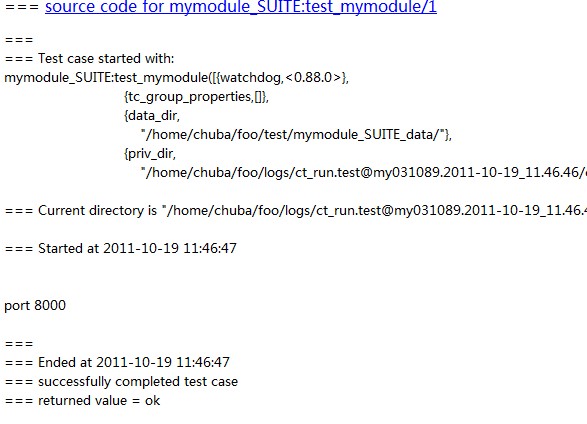系統技術非業餘研究 » rebar和common_test使用實踐和疑惑澄清
rebar is an Erlang build tool that makes it easy to compile and
test Erlang applications, port drivers and releases.rebar is a self-contained Erlang script, so it’s easy to distribute or even
embed directly in a project. Where possible, rebar uses standard Erlang/OTP
conventions for project structures, thus minimizing the amount of build
configuration work. rebar also provides dependency management, enabling
application writers to easily re-use common libraries from a variety of
locations (git, hg, etc).
common_test是Erlang強大的黑盒測試框架 參見這裡
Common Test is a portable application for automated testing. It is suitable for black-box testing of target systems of
any type (i.e. not necessarily implemented in Erlang), as well as for white-box testing of Erlang/OTP programs. Blackbox
testing is performed via standard O&M interfaces (such as SNMP, HTTP, Corba, Telnet, etc) and, if required, via
user specific interfaces (often called test ports). White-box testing of Erlang/OTP programs is easily accomplished by
calling the target API functions directly from the test case functions. Common Test also integrates usage of the OTP
cover tool for code coverage analysis of Erlang/OTP programs.
Common Test executes test suite programs automatically, without operator interaction. Test progress and results is
printed to logs on HTML format, easily browsed with a standard web browser. Common Test also sends notifications
about progress and results via an OTP event manager to event handlers plugged in to the system. This way users can
integrate their own programs for e.g. logging, database storing or supervision with Common Test.
Common Test provides libraries that contain useful support functions to fill various testing needs and requirements.
There is for example support for flexible test declarations by means of so called test specifications. There is also
support for central configuration and control of multiple independent test sessions (towards different target systems)
running in parallel.
Common Test is implemented as a framework based on the OTP Test Server application.
但是common_test由於太強大了,新手使用起來會比較麻煩,經常會碰到些問題,不好解決。
這時候rebar來救助了,它的ct功能把common_test使用的麻煩給解決掉了,讓你輕鬆做測試。
我們先來體驗下:
$ mkdir foo $ cd foo/ $ touch rebar.config $ rebar create-app appid=foo ==> foo (create-app) Writing src/foo.app.src Writing src/foo_app.erl Writing src/foo_sup.erl $ rebar create template=ctsuite ==> foo (create) Writing test/mymodule_SUITE.erl $ rebar ct suite=mymodule ==> foo (ct) DONE. Testing chuba.foo.mymodule_SUITE: TEST COMPLETE, 0 ok, 0 failed, 1 skipped of 1 test cases $ cd logs $ hostname -i 10.232.31.89 $ python -m SimpleHTTPServer Serving HTTP on 0.0.0.0 port 8000 ...
打卡瀏覽器 http://10.232.31.89:8000我們可以看到:
上面我們演示了rebar的ct功能使用的基本步驟,底下是進階資訊:
我們從rebar_ct.erl中可以看到:
%% Global options:
%% verbose=1 - show output from the common_test run as it goes
%% suite="foo"" - runs <test>/foo_SUITE
%% case="mycase" - runs individual test case foo_SUITE:mycase
...
get_ct_config_file(TestDir) ->
Config = filename:join(TestDir, "test.config"),
case filelib:is_regular(Config) of
false ->
" ";
true ->
" -ct_config " ++ Config
end.
...
get_config_file(TestDir) ->
Config = filename:join(TestDir, "app.config"),
case filelib:is_regular(Config) of
false ->
" ";
true ->
" -config " ++ Config
end.
如果test目錄下有app.config 那麼會把它用-config app.config傳給vm, 這個app.config主要用於設定application的環境變數。
如果有test.config, 那麼會把它用 -ct_config test.config傳給vm, 這個test.config主要用於配置測試案例的變數。
test.config規格是類似這樣的,可以參見common_test userguide裡面配置的章節:
{key, value}.
{catalog, [{k1,v1}, {k2, v2}]}.
程式裡面要用方式獲取:
ct:get_config(key).
ct:get_config({catalog,key}).
獲取配置的方式有底下幾種,是很容易混淆的地方,我來解釋下:
test_mymodule(_Config) ->
io:format("port ~p~n", [ct:get_config({foo, port})]),
io:format("priv_dir ~p~n", [?config(priv_dir, _Config)]),
io:format("priv_dir ~p~n", [proplists:get_value(priv_dir, Config)]),
ok.
?config(key, Config).只是用於讀取config變數裡面的值,和proplists:get_value(key, Config)是一樣的。
看程式碼:
-define(config,test_server:lookup_config).
lookup_config(Key,Config) ->
case lists:keysearch(Key,1,Config) of
{value,{Key,Val}} ->
Val;
_ ->
io:format("Could not find element ~p in Config.~n",[Key]),
undefined
end.
現在我們來演示下test.config的使用:
$ pwd
/home/chuba/foo/test
$ cat test.config
{foo, [{hostname, "127.0.0.1"},
{port, 8000}
]}.
$ diff mymodule_SUITE.erl mymodule_SUITE.erl.orig
164c164
< [{require, foo}, {userdata,[{doc,"Testing the mymodule module"}]}].
---
> [{userdata,[{doc,"Testing the mymodule module"}]}].
167,168c167
< io:format("port ~p~n", [ct:get_config({foo, port})]),
< ok.
---
> {skip,"Not implemented."}.
$ rebar ct suite=mymodule
==> foo (ct)
DONE. Testing chuba.foo.mymodule_SUITE: TEST COMPLETE, 1 ok, 0 failed of 1 test cases
當然也可以用ct_run來執行:
$ct_run -suite $PWD/mymodule_SUITE -pa $PWD/ebin -logdir $PWD/logs -config test/test.config Erlang R14B04 (erts-5.8.5) [64-bit] [smp:16:16] [rq:16] [async-threads:0] [hipe] [kernel-poll:false] Eshell V5.8.5 (abort with ^G) Common Test v1.5.5 starting (cwd is /home/chuba/foo) ([email protected])1> Common Test: Running make in test directories... CWD set to: "/home/chuba/foo/logs/[email protected]_11.52.21" TEST INFO: 1 test(s), 1 case(s) in 1 suite(s) Testing chuba.foo.mymodule_SUITE: Starting test, 1 test cases Testing chuba.foo.mymodule_SUITE: TEST COMPLETE, 1 ok, 0 failed of 1 test cases Updating /home/chuba/foo/logs/index.html... done Updating /home/chuba/foo/logs/all_runs.html... done
我們可以看到ct_run是通過-config foo.config 這樣來傳配置檔案的,這個地方和容易和erl -config app.config混淆。
實際上ct_run是個程式,我們看下他的程式碼:
//ct_run.c
...
else if (cnt < erl_args) {
if (strcmp(argv[1], "-config") == 0)
PUSH("-ct_config");
else if (strcmp(argv[1], "-decrypt_key") == 0)
PUSH("-ct_decrypt_key");
else if (strcmp(argv[1], "-decrypt_file") == 0)
PUSH("-ct_decrypt_file");
else
PUSH(argv[1]);
}
...
-config選項會被轉化成-ct_config來傳遞給vm,所以和-config app.config就能分開,但是理解起來確實很惱人。
小結: rebar和common_test配合起來用的很爽。
祝玩得開心。
Post Footer automatically generated by wp-posturl plugin for wordpress.
相關推薦
系統技術非業餘研究 » rebar和common_test使用實踐和疑惑澄清
rebar is an Erlang build tool that makes it easy to compile and test Erlang applications, port drivers and releases. rebar is a self-contained Erla
系統技術非業餘研究 » Erlang match_spec引擎介紹和應用
match_spec是什麼呢? A “match specification” (match_spec) is an Erlang term describing a small “program” that will try to match something (either the para
系統技術非業餘研究 » 區域性性原理在計算機和分散式系統中的應用課程PPT
這個課程最主要focus在資料的區域性性原理,從硬體到作業系統到應用程式這樣的順序過來的,對於我們提高核心系統軟體的效能非常有啟發意義. 課件下載點選這裡 修正:由於原連結已經不存在了,特地在這裡放了一份。 以下是教程的介紹: 課程簡介 ___________________________
系統技術非業餘研究 » Fio壓測工具和io佇列深度理解和誤區
Fio 是個強大的IO壓力測試工具,我之前寫過不少fio的使用和實踐,參見 這裡。 隨著塊裝置的發展,特別是SSD盤的出現,裝置的並行度越來越高。利用好這些裝置,有個訣竅就是提高裝置的iodepth, 一把餵給裝置更多的IO請求,讓電梯演算法和裝置有機會來安排合併以及內部並行處理,提高總體效率。
系統技術非業餘研究 » qperf測量網路頻寬和延遲
我們在做網路伺服器的時候,通常會很關心網路的頻寬和延遲。因為我們的很多協議都是request-reponse協議,延遲決定了最大的QPS,而頻寬決定了最大的負荷。 通常我們知道自己的網絡卡是什麼型號,交換機什麼型號,主機之間的物理距離是多少,理論上是知道頻寬和延遲是多少的。但是現實的情況是,真正的
系統技術非業餘研究 » 大檔案重定向和管道的效率對比
微博上的@拉風_zhang提出了個問題: @淘寶褚霸 請教個問題,#1. cat huge_dump.sql | mysql -uroot ;#2. mysql -uroot < huge_dump.sql ;#1效率要高,在linux中通過管道傳輸 和 < 這種方式有什麼差別
系統技術非業餘研究 » 新的工作和研究方向
和大家更新下: 做了將近8年資料庫後,我的工作和研究方向將會延伸到虛擬化和計算相關的雲服務,希望能夠和大家一起進步,Happy New Year! 預祝大家玩得開心! Post Footer automatically generated by wp-posturl plugin for w
系統技術非業餘研究 » 如何檢視節點的可用控制代碼數目和已用控制代碼數
很多同學在使用erlang的過程中, 碰到了很奇怪的問題, 後來查明都是檔案控制代碼不夠用了, 因為系統預設的是每個程序1024. 所以我們有必要在程式執行的時候, 瞭解這些資訊, 以便診斷和預警. 下面的這個程式就演示了這個如何檢視節點的可用控制代碼數目和已用控制代碼數的功能. 首先確保你已經安
系統技術非業餘研究 » oprofile抓不到取樣資料問題和解決方法
最近有同學反映在某些新機器上做效能調優的時候, oprofile 有時抓不到資料,我之前也遇到這個情況,很是無語,今天特地驗證了下。 # 我們的作業系統和機器配置大概是這樣的: $sudo aspersa/summary # Aspersa System Summary Report ##
系統技術非業餘研究 » Erlang虛擬機器基礎設施dtrace探測點介紹和使用
最新的Erlang虛擬機器(R15B01)很大的一個改進就是加入了對dtrace探測點的支援了, 具體參見這裡, 主要目標是方便在生產實踐中定位複雜的效能問題。 目前Erlang的虛擬機器的探測點支援Linux的systemtap和freebsd的dtrace,我們剛好能夠享受的到。 作者Scot
系統技術非業餘研究 » Erlang 網路密集型伺服器的瓶頸和解決思路
最近我們的Erlang IO密集型的伺服器程式要做細緻的效能提升,從每秒40萬包處理提升到60萬目標,需要對程序和IO排程器的原理很熟悉,並且對行為進行微調,花了不少時間參閱了相關的文件和程式碼。 其中最有價值的二篇文章是: 1. Characterizing the Scalability of
系統技術非業餘研究 » gen_tcp:send的深度解刨和使用指南(初稿)
在大家的印象中, gen_tcp:send是個很樸素的函式, 一呼叫資料就喀嚓喀嚓到了對端. 這是個很大的誤解, Erlang的otp文件寫的很不清楚. 而且這個功能對於大部分的網路程式是至關重要的, 它的使用對否極大了影響了應用的效能. 我聽到很多同學在抱怨erlang的效能低或者出了很奇怪的問
系統技術非業餘研究 » 計算機各系統元件的吞吐量和延遲 看圖不說話
這個圖挺好的,就是比較粗線條,有些東西不太完整/準確,比如現有的USB實際上是480M/12M和1.5M三種速率(暫不算3.0和無線的) 另:幫樓主補充一下這類資料的意義:如果對各種匯流排的速率和IOPS如果沒有概念和預估,寫程式時就只能Compile & Pray了。 Reply:O
系統技術非業餘研究 » 如何在TILEPro64多核心板卡上編譯和執行Erlang
美國Tilera公司的眾核伺服器,單顆核心包含64顆CPU。硬體架構圖: 卡長這樣的: Erlang已經可以在這款CPU上成功執行,我們可以參考Ulf Wiger在Multicore ☺ Message-passing Concurrency 文件中關於Erlang在Tilera上的效能圖
系統技術非業餘研究 » Erlang和port通訊的資料格式
erlang內建的port非常強大,是erlang通往外面世界的通道,所以port和erlang程式的通訊的資料格式影響了通訊的效率,和穩定性。我們在選擇格式的時候, 會優先考慮到erlang的特性和port程式編寫語言的特點,選出一種2者都容易處理的格式。 通訊通常有2種,基於行的文字和2進位制
系統技術非業餘研究 » erlang的profile工具原理和優缺點
erlang的tools application下包含了一系列的profile工具, 包括 eprof cprof fprof, 具體的使用可以參看文件和<< erlang effective guide>>. 我這裡要說的是他們的工作原理。 這些模組的核心都是根據erla
系統技術非業餘研究 » 轉:CPU密集型計算 erlang和C 大比拼
原文地址:http://pseudelia.wordpress.com/2009/08/23/erlang-native-code-benchmark/ Normalerweise compiliert Erlang Bytecode (heißt das so in Erlang?). Das
系統技術非業餘研究 » erlang高階原理和應用PPT
公司培訓用的 湊合看吧 主要講erlang系統的特點,分佈叢集以及mnesia的使用, 從比較高的角度來看erlang, 讓你有了大體觀. Post Footer automatically generated by wp-posturl plugin for wordpress. No
系統技術非業餘研究 » erlang:send_after和erlang:start_timer的使用解釋
前段時間arksea同學提出這個問題, 因為文件裡面寫的很不明白. erlang:send_after(Time, Dest, Msg) -> TimerRef Time = int() 0 <= Time <= 4294967295 Dest = pid() | RegName
系統技術非業餘研究 » 低成本和高效能MySQL雲資料的架構探索
該文已在《程式設計師》2012年10期上發表。 MySQL作為一個低成本、高效能、可靠性好而且開源的資料庫產品,在網際網路企業應用非常廣泛,例如淘寶網有數千臺MySQL伺服器的規模。雖然近兩年來NoSQL的發展很快,新產品層出不窮,但在業務中應用NoSQL對開發者來說要求比較高,而MySQL擁有




